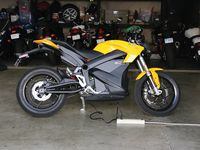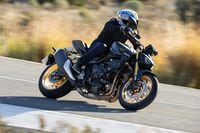WRIST: Ari Henning
MSRP (2015): $17,840 (as tested)
MILES: 401
MPG: Ha!
MODS: None
Update: 1
When the boss suggested we toss a Zero S electric bike into the long-term mix, I volunteered. The way I see it, my short commute is the ideal scenario for a range-restricted eBike, and as a dyed-in-the-wool motorcyclist I'm the right guy to give this bike a straightforward evaluation based entirely on its merits (keeping in mind the Zero's inherent limitations, just like I would when testing a cruiser or a scooter or any other bike). It's clear that tech junkies and environmentalists are excited about eBikes, but will a Zero satisfy the needs and desires of a traditional petrol head? I'm willing to find out.
I’ve followed Zero’s progress since the company’s inception in 2006 (I even applied to sweep the shop as a twentysomething student living down the hill from Zero’s Scotts Valley, California, headquarters) and took a demo ride on its first off-road bike as a consumer. More recently I’ve tested several of the company’s streetbikes and even shared the track with some factory supported eBike racers.
At the track, I watched as the Zeros fired off the starting line only to pogo through the corners, drag hard parts, and overheat. But just a few months later the bikes were finishing races in scorching heat thanks to new cooling methods and the chassis getting sorted out. Racing improves the breed, as they say, and I got to watch it happen in real time.
And it would seem that plenty of what those racers learned has found its way into Zero’s 2015 lineup, which features an overall higher spec this year. This latest batch of battery bikes come with upgraded power packs, more sophisticated suspension, stronger brakes, and better tires.
The Zero S pictured above is the naked sportbike in Zero’s range, a roster that also includes the DS, FX, and SR. The DS is an off-road capable all-rounder (see “Coal vs. Solar,” Sept. 2014, ), while the FX is a lithe little urban hooligan bike, and the SR is a high-performance version of the S with a more robust motor controller that dishes out more current, which provides more power and torque. (The motor is also upgraded to take the heat.)
Zero sells the S in several battery configurations. The base bike has a 9.4 kWh battery that’s said to offer a 113/58-mile city/highway range. This bike came equipped with the popular 12.5 kWh-pack upgrade ($2,000), plus the optional 2.8-kWh Power Tank that costs $2,496, and takes the place of the Zero’s “frunk,” or forward trunk. Range as equipped is stated at 185/94 city/highway, though that highway figure is measured at 70 mph, a good 5 or 10 mph below the pace of smooth-flowing Orange County traffic. Power is listed as 54 hp and 68 pound-feet of torque.
As shown, this is a $17,840 motorcycle. The base bike is a spendy $13,345, with all those battery upgrades adding expense, heft, and charging time in addition to range. Balanced on our scales the bike is 452 pounds. That’s not especially heavy, but given the bike’s compact size (about 80 percent the size of a Triumph Street Triple R) it feels quite dense. I sure hope I never run out of juice and have to push this thing home!
So far I’ve ridden the Zero to and from work three days with a few errands thrown in—racking up about 65 miles total—on a single charge. When I got home on the third day I plugged the bike in (with 14 percent battery remaining) and it was fully charged the next morning. It’s clear the Zero will work wonderfully as a daily rider.
So how is it to ride? Fine. It’s not especially dynamic or exciting, but as utilitarian transportation it’s excellent. There’s no need to warm up the motor and no need to shift gears since it’s a direct-drive setup. And there is something to be said for never having to detour to a gas station on my way to or from work.
The bike has three drive modes—Eco, Sport, and Custom—and I’ve ridden it almost exclusively in Sport simply because I like to go fast. Once underway, acceleration is impressive. It'll squirt from 50 to 70 mph in an instant, but off-the-line performance is pretty soft, akin to a 250cc scooter. I can manipulate the Custom ride mode from my iPhone with the free Zero app, so I'm looking forward to exploring that and hopefully dialing up the initial throttle response.
I’m also looking forward to taking the S on some twisty roads to test the handling. The Zero is excellent for commuting, but that’s only part of the equation for the typical motorcyclist.












/cloudfront-us-east-1.images.arcpublishing.com/octane/OKWOJWAKP5EP3OACCRRWPCIX2Q.jpg)
/cloudfront-us-east-1.images.arcpublishing.com/octane/2WF3SCE3NFBQXLDNJM7KMXA45E.jpg)
/cloudfront-us-east-1.images.arcpublishing.com/octane/G4MG6OUCJNBSHIS2MVVOTPX65E.jpg)
/cloudfront-us-east-1.images.arcpublishing.com/octane/IIGGWFOTOJGB7DB6DGBXCCMTDY.jpg)
/cloudfront-us-east-1.images.arcpublishing.com/octane/QSTCM6AVEZA5JJBUXNIQ3DSOF4.jpg)
/cloudfront-us-east-1.images.arcpublishing.com/octane/U4I7G625B5DMLF2DVIJDFZVV6M.jpg)
/cloudfront-us-east-1.images.arcpublishing.com/octane/B6XD6LS6IVCQPIU6HXDJSM3FHY.jpg)
/cloudfront-us-east-1.images.arcpublishing.com/octane/ICL63FEDDRDTTMINYICCEYGMDA.jpg)
/cloudfront-us-east-1.images.arcpublishing.com/octane/FCGZHQXRBZFLBAPC5SDIQLVF4I.jpg)
/cloudfront-us-east-1.images.arcpublishing.com/octane/WNOB6LDOIFFHJKPSVIWDYUGOPM.jpg)

/cloudfront-us-east-1.images.arcpublishing.com/octane/X33NU3E525ECRHXLNUJN2FTRKI.jpg)
/cloudfront-us-east-1.images.arcpublishing.com/octane/6KKT5NNL2JAVBOXMZYS5ZO76YA.jpg)
/cloudfront-us-east-1.images.arcpublishing.com/octane/J5RKG5O455GMPGQRF2OG6LRT7A.jpg)
/cloudfront-us-east-1.images.arcpublishing.com/octane/GX2CIZKQVRH2TATDM26KFG2DAE.jpg)
/cloudfront-us-east-1.images.arcpublishing.com/octane/ZWIDYSAKQZHD5BHREMQILXJCGM.jpg)
/cloudfront-us-east-1.images.arcpublishing.com/octane/CYUHJZCTSJCH3MRAQEIKXK7SCQ.jpg)
/cloudfront-us-east-1.images.arcpublishing.com/octane/LKOFINY56FCXJCANJ5M7ZDQUBY.jpg)
/cloudfront-us-east-1.images.arcpublishing.com/octane/4NBPDACMWJH63JQYJVK3QRBDZI.jpg)
/cloudfront-us-east-1.images.arcpublishing.com/octane/KKHQHRR3FJGX7H2IPU6RALMWG4.jpg)

/cloudfront-us-east-1.images.arcpublishing.com/octane/5IOFS5JAE5FOXMNA23ZRAVVYUU.jpg)
/cloudfront-us-east-1.images.arcpublishing.com/octane/CGXQ3O2VVJF7PGTYR3QICTLDLM.jpg)
